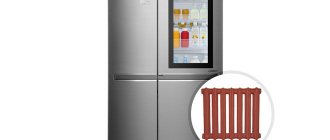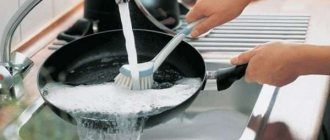Heating Systems Basics
In general, according to the regulations of utility services, it is prohibited to interfere with the operation of the central systems of the house. In exceptional cases, when the battery is leaking or has ruptured, emergency intervention is permitted. But if the heating system in your home is connected to the central system correctly, then you can try turning off the heating yourself. There is nothing particularly difficult about this.
Correct connection means that the heating is connected to the general system using two ball valves (Figure 1) and a jumper called a bypass (Figure 2). This connection is called one-pipe. (Figure 3)
Figure 1 – Two taps
Figure 2 – Bypass jumper
Figure 3 – One-pipe system with a jumper. It can be covered
Important Modern heaters are filled with water, which plays the role of a coolant. In winter, hot water flows through the heating pipes, and cold water in summer. Oddly enough, it is filling with water that saves the insides of the radiator from rusting from the inside. After all, if all the water is drained from the heating system, then its remaining drops will create a microclimate for the formation of corrosion.
The right approach to covering
Owners of private houses do not have to worry about repair work or emergency situations, because they have an individual heating system. It is much more difficult for people in apartment buildings. It is especially difficult where vertically installed single-pipe systems are located. After all, during any work with heating devices, this process immediately affects the neighbors. That is why it is important to properly turn off the radiator in the apartment without harming others.
During the heating season, interference with the operation of the central systems of the house is not allowed. As an exception, shutdown is permitted in cases of emergency leaks or leaks. But if the batteries are connected to the common system correctly, then they can be turned off during the heating season without disturbing the neighbors.
This is possible if the battery connection diagram is made using two taps, as well as a bypass line. When the devices are connected in this way, the sequence of work on the ceiling is simple. First you need to turn off both taps, and after carrying out the necessary work, open them again.
If the house is hot, but you don’t want to open the window in order to save money, then you can turn off the radiator for a while. In this case, it would be better to install thermostats on batteries. With their help you can maintain a certain temperature in the room.
If connected correctly, the heating battery can be turned off at any time, be it summer or winter. To do this, the tap and valve, which are located at the pipe insertion into the collector itself, must be closed. They overlap clockwise, in other words, to the right. However, do not forget about the other residents of the house. They must be warned about the closure in advance, and a sign must be placed on the valve so that no one can open it during the repair work.
As can be seen from the above, it is possible to turn off the heating when the piping scheme is done correctly, or in the event of an accident.
In case of emergency
If an emergency occurs and water begins to flood the room, then the situation must be saved. In such a situation, you don’t need to think about anything, but only about shutting off the water in any way. Since in such a situation the neighbors who are located below may also suffer.
With a very small leak, there will be enough time to call a locksmith. If an emergency situation can lead to a flood, then actions must be quick and concentrated. First you need to turn off the taps located on the connections to the batteries. This must be done even without a bypass. If there are no shut-off valves, then you need to call professionals and, if possible, close the riser before they arrive. To do this, you need to go down to the basement and find a shut-off point, that is, two vertical pipes, and shut off.
For the summer
When shutting off the heating battery for the summer, you need to know that every system with water heating must be filled with water all year round. After all, if there is no water in the pipes, then air will get in, resulting in corrosion. In multi-apartment building systems, it is impossible to check the state of affairs, so you can only hope for the conscientious attitude towards the work of utility service employees.
However, you can do something yourself to save your heating system from damage. To extend the life of the batteries, you need to close the valve on the radiator yourself at the end of the heating season. In this case, utility workers, carrying out any repair work, can drain water from the system, and at the same time water will not be able to leave the radiators.
If the radiators are made of cast iron, then you do not need to worry about overlapping, because this material is not afraid of corrosion. When the heating system starts up in the fall, there is no need to rush to open the tap immediately on the first day. It is better to wait and open on the second day, while bleeding the air using the Mayevsky tap. This is done to prevent the pipes from becoming clogged with rust that moves through the pipes.
Correct procedure
A bypass is a small branch from the common riser in the form of a connecting jumper between pipes. The presence of a bypass will ensure that you are cutting off the battery only in your apartment, and not in the entire house. If your heating system is connected exactly as in the figures above, then in order to shut off the battery you need to use taps. The question arises: should you use the top or bottom tap?
You need to know right away that you don’t need to close two taps! As we already know, hot water flows through the pipes in winter, heating the heater. If you turn off both taps, the temperature of the water inside will drop sharply. It would seem that this is what we need! But at the same time, the volume of water filling the radiator will decrease. And the empty space will be filled by a vacuum, which creates pressure inside.
As a result of excess pressure, the battery may crack or even burst! To painlessly turn off the heating if you are hot, you just need to close the bottom tap. The top one remains open so that the heater is full and does not create a vacuum or air pockets.
That is, your procedure consists of 3 points:
- Feel that you are hot.
- Make sure your system is equipped with valves and a bypass.
- Close the bottom tap, but do not touch the top one.
Energy consumption for a bypass pipe with a thermostat
Installing a thermostat has a beneficial effect on energy costs. Compared with a conventional flow pipe, in a system with a bypass pipe, hot water consumption is reduced by 30-35%, and heat transfer from the radiator is reduced by 10%. This is of no small importance when there is excess heat in the heating system, that is, when the apartment is hot. This indicates the effectiveness of the system using a bypass for creating comfortable conditions in the room, and payments for energy consumption are significantly reduced.
Why turn off the battery at the beginning of the heating season?
As soon as they announce that the heating season has begun, it is better to immediately turn off the battery to avoid blockages. The fact is that when hot water starts running, a huge amount of slag will flow through the pipes, which clogs the radiators. Turn on the battery on the second day after the start of the season. This is done simply, open both taps and bleed the air through the Mayevsky tap, which is equipped with most radiators.
Interesting When closing pipes in the summer, you must always remember that the battery must always be filled with water. By closing the valve on the radiator after the end of the heating season, you will leave it filled with water. This will prevent corrosion.
How to shut off a battery without a valve
Let's say that your apartment is heated by a two-pipe heating system; it is not equipped with a shut-off jumper and taps. As a rule, these are outdated cast iron monsters that are still found in homes. Is it possible to block it?
Figure 4 – Battery connected without a jumper in a two-pipe circuit
Unfortunately, it is impossible to turn off such a system during the heating season. By shutting off this battery, you will block the riser and the whole house will freeze. You can turn off the two-pipe circuit yourself only if a pipe in your apartment breaks, or if the battery leaks.
This is done as follows:
- Go to the entrance heating point.
- You are looking for 2 vertical pipes that go up to your apartment.
- Turn the taps on them, i.e. turn off the heating throughout the house.
- Explain the situation to your neighbors.
Results
To fully monitor heating radiators, the following devices are required:
- Ball Valves;
- Bypass with tap;
- Drain tap or hole;
- Thermostat;
- Device for removing gases.
https://www.youtube.com/embed
It is quite easy for the owner of a private house to adjust or repair heating radiators, because he has an individual system. It is more difficult for owners of apartments where vertical single-pipe systems are installed and any manipulations with heating devices in winter can affect their neighbors. The purpose of this article is to explain how to properly shut off the battery in an apartment without causing harm to others.
What is required to work safely?
When the apartment is hot enough and the owners want to turn off the heating radiator, then you can consider installing a temperature regulator on the batteries. If there is a bypass, a thermostat is installed on the radiator, which regulates the temperature in the room. If there is no bypass, then you cannot install a regulator, because this can regulate the temperature not only in this apartment, but also in the neighbors on the riser. In such a situation, you just need to replace the heating radiator and install a bypass.
Bypass unit and functions
Using a bypass, repair work can be carried out at any time, even in winter, if hot circulating water is available. You just have to turn off the tap located in front of the radiator. Water will immediately stop flowing into the pipes, and circulation will go through the bypass itself. This will allow the apartment owners not to go down to the basement and not block the common riser.
The device itself consists of pipes having a smaller diameter than the pipes of the outlet and supply lines. The presence of two ball valves allows you to properly shut off the radiator and direct circulating water through the bypass.
DESIGN PLACE FOR PLAY
Create a separate space in the room where the baby will be awake. Let the toys lie there, a place will be “cleared” for rolling cars or building pyramids, and don’t let chairs, a table, or a closet get in the way. The child should play with pleasure, he needs a certain place for this. And at the same time, you should not worry that, having played too much, he will crawl in the wrong direction and hurt himself on the table leg, or turn the chair over on himself.
The principle of adjusting the temperature of heating radiators
It is directly related to the design features of this element and its installation. The valve is a ball with a through hole.
The operation of the crane is controlled using a handle fixed to the ball by a rod.
Important! To install the device, you need to choose the location wisely so that turning the handle in the future does not interfere with other devices of the heating system. The diameters of the tap and pipe must be identical.
The diameters of the tap and pipe must be identical.
The device must be fixed in parallel
as it is twisted using tow or special tape. They provide the mechanism with additional protection against leaks. The correct installation is further verified by applying water pressure.
Photo 1. Ball valve device for adjusting the temperature in a heating radiator. Arrows indicate parts of the product.
Activating the handle promotes the movement of the mechanism around its own axis. Rotating the ball hole to the nozzles and pipeline inlets makes it possible to circulate coolant through it
, otherwise the fluid flow will be blocked.
The ball in such mechanisms can be fixed and movable. In the first case, it is attached to the rod so that it remains completely static. The tightness of such a connection is ensured by bolts or disc springs.
The movable ball is capable of moving depending on the degree of water pressure on it
. Due to this possibility, this type of mechanism is more widespread than the first.
How to open a tap
This is done to supply the maximum possible amount of coolant in order to provide the room with heat. To adjust the mechanism, you need to turn the handle parallel to its own axis and the pipe.
For convenience, there are protrusions on the faucet body indicating restrictions on the degree of its opening. This is done counterclockwise.
How to close
With this action, the circulation of the coolant completely stops. This needs to be done when there is a need to reduce the radiator temperature to a minimum, for example, in the summer.
The handle of the device in the “closed” position should form an angle of 90 degrees with its axis and the pipeline.
According to the protrusions, the movement of the handle to stop the fluid circulation should be done
clockwise.
Reference.
In both situations, in the absence of a handle, it is possible to determine the position of the tap
by the groove
. If it is aligned with the pipeline and the mechanism itself, then its position is “open”, otherwise the fluid flow is blocked.
How to turn a jammed tap on a battery and adjust it
Often this situation arises if the position of the mechanism is not periodically changed and developed as a preventive measure.
Before taking directed steps to repair the device,
it is worth trying to do it yourself.
If you need to close the heater without removing it
If you need to close the heating battery for the summer or turn it off because of the heat, this is very easy to do if the heating battery has shut-off valves - valves with a spherical shut-off element. Turn the handle of the valves on the inlet and outlet pipes all the way. Likewise, the flow of coolant will be blocked.
In the photo the taps are open. When closed, the valves of the taps are placed perpendicular to the pipe.
Very often there is a specialized control valve on the incoming pipe. It can also be used to close the pipe. However, its key function is considered to be maintaining a specific temperature regime in the room.
Shutting off the heating device without dismantling it is made in the following options:
- The battery needs to be painted (during the heating season).
- The battery needs to be flushed.
- You need to change the gaskets and nipples.
- It is necessary to close the heating battery for the summer.
What to do with a stuck ball valve
When ball valves are not used for their intended purpose for a long time, they begin to jam due to the formation of scale. Do not use brute force to try to open the valve using a gas wrench or pliers. When the faucet handle does not unscrew immediately, then:
- You need to unscrew the fixing nut and remove the “butterfly” from the rod.
- Under the “butterfly” there is a nut that secures the plastic seal, which needs to be loosened. A key is used and the tap is turned half a turn.
- It is also possible to use a tool that allows you to firmly grasp the stem. It is possible to use an adjustable wrench. The rod turns without excessive effort.
- If resistance is felt, you need to move in the opposite direction, gradually increasing the amplitude by 5 degrees.
- It is necessary to develop the rotation of the rod until a right angle is formed. If this result is achieved, the gland nut is returned and the butterfly handle is installed.
Important! When you have WD-40 lubricant in the house, apply it to the soured rod and leave for 10 minutes. This makes it easier to unscrew.
How to turn off a radiator without shut-off valves
Sometimes radiators made of cast iron or steel can be installed in a home. The design of these devices does not require cut-off fittings. In this regard, it will not be possible to turn off the appliances during the heating period.
The old heating scheme involves connecting radiators in apartment buildings to risers without bypasses. If there is no cut-off reinforcement, the action algorithm is as follows:
- You will need a container where the water will drain. There are situations when the flow hits the side with powerful pressure. In such a situation, you need to wrap a rag around the area where the hot water comes from.
- It is necessary to notify the heating company of the home about the situation.
- It is important to take care of access to the basement, find the keys, and open the door.
- Try to close the riser on your own.
To turn off the heating riser, you need to go down to the heating station in the entrance. It is necessary to find vertical pipes embedded in the main line. Then you will need to determine the emergency riser in the apartment building for proper closure.
When you have managed to turn on the tap, you need to call your household back and find out if the radiator has stopped leaking. If the problem cannot be solved, you need to open the riser valve and continue the search. It is necessary to close the available valves one by one until the pipe responsible for the apartment is found.
How to behave when turning on the heating in the fall
In fact, even in the fall it is important to properly turn off the radiator. After you find out about the heating switch-on date, you need to take some actions. You remember that when you turn on the heating, only rust will pass through the pipes. That is why in this case it is recommended to close both taps at the same time, which will eliminate the possibility of clogging the battery.
It is enough to leave both taps closed for one day. And don’t worry if a sharp cold snap is predicted the next day: the water will not cool down so much that a vacuum begins to form in the battery. Then you can open both taps and leave it like that until the end of the heating season, when you need to turn off the radiator in the apartment again.
Very important information
Below we will describe situations when one or another inclusion of the battery may be undesirable, and sometimes unacceptable!
4.1.You cannot use the thermostat without a jumper
In point 2 we talked about the thermostat. However, you need to understand that experiments with a temperature controller are only possible with a jumper! If it is not there, and you reduce the diameter of the flow pipe, then the total flow of hot water through your apartment will decrease. Which of course is unacceptable, otherwise your neighbors will come to you!
4.2. The thermostat may become clogged
If you are using a jumper, but for some reason it was turned off for a while and the thermostat was set to position 5, i.e. provided a full flow of hot water only through the battery, as shown in the figure:
then everything seems to be fine. However, we must accept reality as it is. Even if we turned on the central heating radiators correctly for the first time, there is no guarantee that, for example, in a month or two a new mud flow will not pass through the pipes. But then, if the jumper is turned off, then the splash of dirt will go straight to your thermostat, which, in fact, is very sensitive to it. As a result, a blockage forms in the thermostat, and water will not flow into the battery at all. It won’t go into the jumper either, because you closed it. Therefore, in this situation, water will stop flowing through your apartment; in the house, through your heating riser, the water will also stop and begin to cool in the cold. As a result, a squad of evil neighbors, together with the chairman of the HOA or housing cooperative, is guaranteed to enter your apartment.
It is clear that switching on according to the above figure is similarly not acceptable for the regulator positions 4,3,2,1,*
4.3. The jumper must always be on
Make it a rule that it doesn’t matter whether you use a temperature controller or not, but the jumper should always be on. Thus, you will always ensure the flow of hot water through your apartment
When does it make sense to turn off the jumper? For example, when you feel that the battery is clogged. Then you let all the water flow through the battery by disconnecting the jumper. Perhaps a more powerful stream of hot water will be able to push through the stuck dirt. But this needs to be done for a short time and only under your control - you cannot leave the situation like this and go to sleep. The fact is that if the dirt cannot be pushed through, then a congestion will form again: water will not be able to pass through either the battery or the jumper.
This is mega important, because if it is installed before the jumper, then when you first turn it on, dirt will definitely clog your thermostat, and you will start the heating season with a complete rewiring of the battery:
Replacing the battery in winter
One of the frequently asked questions is whether it is possible to shut off the battery in winter? In general, this is prohibited. At the same time, it is technically possible. In any case, in winter it is recommended to turn off the batteries only if an emergency occurs, since this most often leads to the need to turn off the heating risers. However, there is an option in which you don’t have to turn off the heating risers. Then the radiators must be equipped with bypasses - specialized jumpers with taps. Thus, the access of water to the radiator will be blocked and, at the same time, will not disrupt the circulation of water in the system. (See also: How to choose heating radiators)
Three types of bypasses
There are three types of bypasses:
- Unregulated - simple pipe;
- With manual control – valve with divisions;
- Automatic – with sensors;
The latter option is installed in a harness with a pump. Typically, automation is used when circulating a coolant along a circuit. An electrically powered pump allows you to increase the flow rate, which helps reduce heat loss. Most often, such a system is used in private homes or when connecting heated floors to the heating system in apartment buildings. In the event of a power outage, the coolant flow passes through the bypass. The impeller restricts the flow of water. It is supplied to the market in two variations: injection and valve. The biggest disadvantage of an automatic bypass: if the water contains scale, scale, rust and other contaminants, it quickly fails. The bypass must be installed in a single-pipe system; if it is necessary to make a collector wiring, the jumper allows you to divide the flows into two parts, providing both radiators with coolant in equal proportions. With horizontal wiring, the bypass is installed parallel to the main line below the normal wiring. When installing standard three-quarter inch pipes, it is recommended to install a bypass at one-half inch. In this case, the pipes of the incoming and outgoing coolant flow should have a diameter of 1 inch.
Tool preparation
Before replacing, you need to prepare a special tool:
- Adjustable wrench,
adjustable wrench
- "Bamka" key
"Bamka"
- Electric drill,
- Drill for working on concrete of the appropriate diameter,
- Angle grinder (“grinder”) with a diamond disc for processing metal surfaces,
Bulgarian
- Tape measure and folding meter,
- Construction pencil, which will be used for marking,
- Water level (“spirit level”).
Level
Important! If you are unable to reach an agreement with your neighbors above or below, you will need a tool, which is necessary for cutting threads. The external thread is cut on the pipe near the floor and under the ceiling.
Disabling the heating riser
Problems associated with disconnecting the riser are often the most difficult to solve. When replacing heating batteries, the riser will need to be turned off for at least half a day. According to the law, the riser belongs to joint property.
Access to public property must be provided by the appropriate utility service, which has the necessary permits and is responsible if anything goes wrong.
Basement with taps
What does this mean in practice? It is necessary to write an application to the operational office. Based on this document, utility services are required to turn off the riser at the time specified in the application. By law, this is a paid service. This pleasure costs 15 – 20 US dollars.
You can negotiate cheaper with the chief engineer, foreman or one of the foremen. Local plumbers will turn off the risers. It will cost ten dollars.
conclusions
Services for disconnecting water supply risers for the purpose of carrying out any work on the individual property of the owner of the premises are performed by the management company/homeowners association outside the scope of services and work on the maintenance of residential premises and are subject to separate payment by the owner, on the initiative and for whose purposes such services are provided.
The position presented in this article is confirmed by a number of judicial acts, including: 1. Appeal ruling of the Moscow City Court dated June 24, 2013 in case No. 11-1916013;2. Decision of the Sovetsky District Court of Krasnoyarsk dated July 12, 2011 in a civil case at the claim of the prosecutor of the Sovetsky District of the city.
Krasnoyarsk, in the interests of an indefinite number of persons, to LLC "Enterprise Zhilremservis" to recognize as illegal the actions of collecting fees from citizens for performing work to disconnect hot and cold water supply risers;3. Resolution of the Sixth Arbitration Court of Appeal dated September 13, 2013 No. 06AP-3487/2013 in case No. A73-4100/2013.
Crimping
When the heating is turned on (at the beginning of the water supply to the network), the plumber should be near the tap in the basement in order to quickly shut off the water supply in case of an emergency. The procedure for supplying coolant under pressure into the system is called “pressure testing”. At the same time, the integrity of the heating system is checked.
When performing pressure testing, special equipment is used: a pressure gauge and a pump, which creates pressure. If the pressure in the system does not drop when coolant is supplied, then there is no leak in the network. If the pressure drops noticeably over time, it means that the tightness of the system is broken, and it is necessary to find damage to the lines and heating devices.
Crimping
Selection of material
If we consider the most popular material, it turns out that nothing is used more often than reinforced polypropylene and metal-plastic pipes.
What is the rationale for this choice?
- Replacing the heating riser in an apartment is quick, since there is no need to weld the pipes to one another.
- Pipes made from these materials are easy to bend, so they can be easily integrated into any corners and rooms.
- The components are relatively light in weight, so there is no problem of transportation even to the highest floors.
From all sides, the selected materials look almost ideal, but they react poorly to changes in pressure in the pipes. So, if it jumps sharply from the standard 5 atmospheres to 10, then the pipes may not be able to withstand it, which will lead to a small flood and an urgent call to a mechanic.
In addition, these materials do not withstand the coldest times of the year, when the batteries have to be heated to the maximum. The plastic may begin to crack and leak, so installing galvanized pipes is the best option.
Independent shutdown of risers
In small towns, it is quite common to turn off the heating on your own.
The riser is turned off by a valve in the basement, where it connects to the so-called sun lounger. Water valves are usually in plain sight. To find fittings to shut off heating, you must either have technical documentation or an experienced plumber who is familiar with city local communications.
As a rule, the heating system is closed with an old brass Soviet valve or valve.
Heating tap in the basement
What else you should know
If you are wondering how to turn off the battery if there is no tap, then there is a solution here too. True, the option of blocking the riser is inevitable here. In this case, not only the individual battery will be blocked, but also part of the heating system. In small cities, the practice of turning off the heating independently is often used, just by shutting off the riser. It is turned off using a valve in the basement. At that point he approaches the sun lounger. Water valves are usually within sight.
You can find out which fittings are suitable for shutting off the heating in the technical documentation. Additionally, this should be known to an experienced plumber who is familiar with local utilities. In most cases, the heating system is shut off using a brass valve or a valve.
In the event that the window sill blocks the battery, there is no single solution. It all depends on the degree of overlap. So, for example, if the window sill completely blocked the battery, then this is considered unacceptable. This is explained by the concept of convection, in which warm air rises. There it replaces cold air, which goes down, after which it is heated by the battery. Thus, the room is heated. If the window sill completely blocks the radiator, then the convection process is hampered and the room does not warm up well. But there will definitely be a way out of this situation. You can make several rectangular holes in the window sill and cover them with decorative grilles.
- So, shutting off the batteries in an apartment is possible and, in some cases, even necessary. This can be most conveniently accomplished with special taps.
- After the end of the heating season, it is recommended to close one of them and leave the second open.
- On the day of heating, we close both taps for 1-2 days so that rusty water flows and eliminates the possibility of blockages.
- If there is no tap, then you will have to shut off the riser using a special valve or valve, which are most often located in the basement of the building, and usually in a visible place.
The main thing is to do everything thoughtfully and strictly in accordance with all standards and requirements. Do not close both taps at the end of the heating season, this may cause deformation and cracks in them. Do not forget about the basic rules that will help you shut off the battery in your apartment safely and correctly.
Examples of using bypass
Example #1 - adjusting the coolant
The functional purpose of the bypass is to return excess coolant from the heating battery to the riser when its quantity changes using a manual or automatic thermostat. In other words, the coolant is transported through the bypass parallel to the shut-off and control valves. Without this element, it is impossible to repair the battery when the heating system is in working order. The bypass also speeds up the process of filling or emptying the system.
This is how a bypass can be introduced into a heating system
Example #2 - system operation without electricity
Installing a bypass in a heating system is especially important when installing modern heating systems that involve the use of circulation pumps. People who are faced with heating installation for the first time often ask the craftsmen or consultants in stores: “How will the system work if the electricity goes out?” After all, everyone is accustomed to the fact that the standard floor-standing boiler used in the past was not connected to electricity. And equipping the heating system with a circulation pump makes it energy-dependent.
That's exactly where the bypass comes to the rescue in such situations. Its role in this case is very simple - at the moment of a power outage in the network, the consumer must turn off the coolant supply taps to the pump and open the tap on the central pipe. By the way, this can happen automatically if a bypass with a valve is used. These simple manipulations switch the heating system to natural circulation mode.
Installation of devices on the bypass should be carried out towards the coolant in the following sequence:
- filter;
- check valve;
- circulation pump.
It is important to note that the introduction of a bypass into the riser near the circulation pump must be carried out using shut-off valves. It is better to install the element itself horizontally. In this case, the system will be protected from air accumulation
In this case, the system will be protected from air accumulation.
Schematic representation of a bypass pipe built into the heating system
Example #3 - resuscitation of single-pipe heating
Yes, the single-pipe heating system is obsolete today, but it can still be found quite often in Soviet-built buildings. Moreover, there are such miracles when such heating functions very efficiently even in apartments in winter, it’s simply hot. Installing a bypass will also help correct the situation. In principle, there is nothing complicated in this work, but it is still worth meeting some conditions:
- The bypass should be located at the maximum distance from the vertical section of the pipe, that is, as close to the battery as possible.
- The bypass pipe can be made directly at the installation site - a pipe, a tee and welding work will be required. Or you can purchase such an element ready-made and install it on threaded connections.
- The radiator inlet and bypass must be separated by a control valve or radiator thermostat.
By installing such a device, you will get a banal “temperature regulator in the house.”
Tips and tricks
Experts recommend using the following devices during the heating period to close heating devices:
- Ball Valves;
- bypass;
- drain;
- thermostat;
- device for eliminating gas residues.
To shut off the radiator in your home and avoid adverse consequences, the best solution is to call emergency services. If an accident occurs, you should not panic; you need to turn off the heating. For these purposes, the design of existing overlapping devices and the location of their installation are being studied.
Knowing how to turn off the heating in an apartment, you can decide how to prepare for the heating period in the summer. The installation of bypass and ball valves is carried out by specialists who will shut off the water inside the riser.
List of circumstances when this is necessary
Even in the absence of any natural disasters or major problems, there are many circumstances when it is imperative to close the heating radiator.
Here are the most relevant ones:
- transition to summer;
- check before opening the heating period;
- replacement and repair of heating devices;
- dangerous situation;
- if the room is very hot.











